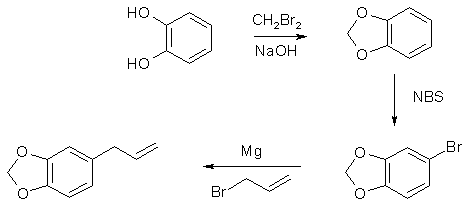Safrole can be synthesized in three steps from unwatched chemicals in good yield:

- Catechol (1,2-dihydroxybenzene, or pyrocatechol) is reacted in a basic solution with dibromomethane (CH2Br2) to 1,2-methylenedioxybenzene.
- The 1,2-methylenedioxy- benzene is selectively brominated with N-bromo- succinimide to form 4-bromo- 1,2-methylenedioxybenzene.
- The 4-bromo-1,2-methylenedioxy- benzene is reacted with Mg to give the Grignard adduct (R-MgBr), and coupled with allyl bromide to form safrole.
Diethyl ether can always be substituted by more harmless and non-watched tert-butyl methyl ether.
All preparations are improved in the given procedure.
Experimental
1,2-Methylenedioxybenzene (1,3-benzodioxole)1,2
In a 2L-round bottom flask with two neck adapter (reflux condenser, dropping funnel) immersed in an oil bath / magnetic stirrer, are placed 95 mL (1.36 moles) of dibromomethane, 180 mL water and 4-5 mL trioctylmethylammonium chloride (PTC, "Adogen 464, Aliquat 336"). On the top of the reflux condenser, a tube is drawn to a gas washing bottle to give some protection against the atmosphere.) The contents of the flask are heated and stirred to reflux and a previous made solution of 100 g (0.91 moles) 1,2-dihydroxybenzene (catechol), 91 g sodium hydroxide (2.275 moles) and 450 mL water is added to the flask (the contents are stirred vigorously and refluxed continously). The addition time is 120 min, thereafter the contents are stirred and refluxed 90 min. The product is distilled with steam (add water continously to flask, distill off water and product). After 1.5 liters of distillate are collected, the distillate is saturated with table salt, and extracted three times with ether (better: tert-butyl methyl ether, non watched, and not so dangerous). The etheral extracts are dried with sodium sulfate, the whole is filtered, and the drying agent washed with 2x30 mL of solvent. The combined filtrates are evaporated (rotavap), and the residue is distilled in vacuum. At 60-80°C (20 mmHg), 87 g 1,2-methylenedioxybenzene distills, containing about 8% of unreacted dibromomethane. The gum in the reaction/distillation flasks is removed with organic solvents.
4-Bromo-1,2-methylenedioxybenzene3,4
In a 500 mL-round bottom flask with reflux condenser (situated in an oil bath and with magnetic stirrer) are placed 70 g of the product from step 1 (92% pure 1,2-methylenedioxybenzene, 0.53 moles), 100 g N-bromosuccinimide and 260 mL chloroform (dry). After three hours of refluxing and stirring, the solution is cooled to room temp, and the the succinimide is filtered off with suction, and washed with 2x20 mL of chloroform. The combined filtrates are evaporated, and the residue is vacuum distilled. At 125-135°C (40 mmHg), a mixture of product and succinimide distills, which is diluted with twice the volume of diethyl ether, stored 3 hrs. over solid sodium hydroxide and washed thoroughly with water. After thorough drying over sodium sulfate, the drying agent is filtered off and washed with 20 mL diethyl ether. The ether is evaporated (rotavap), the yellow-brownish residual oil is sufficiently pure for the next step (the refractive index at 25°C is 1.583). The yield is 72 g, 67% of theory calculated to pure 1,2-methylenedioxybenzene being used.
3,4-Methylenedioxy-allylbenzene (Safrole)5
In a 500 mL flask (immersed in a magnetic stirrer / oil bath) are placed 10-11g magnesium turnings, and 150 mL tetrahydrofuran (freshly distilled from sodium). After the addition of a little iodine crystal and 2 mL dibromomethane to start the Grignard reaction, the 72 g of 4-bromo-1,2-methylenedioxybenzene (step 2) are added to maintain gently reflux. To start up, heating of the bath to 50°C is recommended. After the addition, which takes about 60 min., the whole is stirred and refluxed 1 hr., and the brown liquid is rapidly decanted to a very dry 500 mL flask with dropping funnel and reflux condenser. The magnesium turnings are washed with additional 20 mL dry THF, the washing is added to the Grignard solution. A little (0.5 g) copper(I)iodide is added, and with cooling in an ice-bath, 40 mL (0.47 moles) allyl bromide are added dropwise, the internal temperature should not exceed 40°C. After standing overnight, followed by 1 hr of refluxing, the reaction mixture is suspended in a solution of 20 mL 37% hydrochloric acid in 500 mL water and this is added to 80 mL 25% ammonia, and the solution is steam distilled as above. After collecting 2 L distillate, the distillate is acidified to congo red (pH 4) with hydrochloric acid, saturated with table salt, and extracted with 4x200 mL ether. The combined extracts are dried with sodium hydroxide, evaporated (rotavap), and the residue taken up in ether, and washed thorougly with sodium hydroxide. After drying (sodium sulfate), the drying agent is filtered, washed with 20 mL ether, and the combined extracts are evaporated. The residue is vacuum distilled, 39 g (67% of theory) of safrole, boiling at 120-130°C (20-25 mmHg), are obtained. Colourless and typically smelling oil. Total yield (from the catechol), 32-33% of theory.